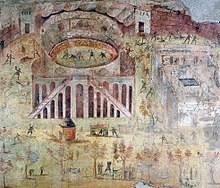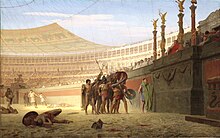
The Colosseum is an elliptical amphitheatre in the centre of the city of Rome, Italy, just east of the Roman Forum. It is the largest ancient amphitheatre ever built, and is still the largest standing amphitheatre in the world, despite its age. Construction began under the Emperor Vespasian in 72 and was completed in AD 80 under his successor and heir, Titus. Further modifications were made during the reign of Domitian. The three emperors who were patrons of the work are known as the Flavian dynasty, and the amphitheatre was named the Flavian Amphitheatre by later classicists and archaeologists for its association with their family name (Flavius).

An amphitheatre or amphitheater is an open-air venue used for entertainment, performances, and sports. The term derives from the ancient Greek ἀμφιθέατρον, from ἀμφί, meaning "on both sides" or "around" and θέατρον, meaning "place for viewing".

The Pula Arena is a Roman amphitheatre located in Pula, Croatia. It is the only remaining Roman amphitheatre to have four side towers entirely preserved. It was constructed between 27 BC and AD 68, and is among the world's six largest surviving Roman arenas. The arena is also the country's best-preserved ancient monument.

A theater, or playhouse, is a structure where theatrical works, performing arts, and musical concerts are presented. The theater building serves to define the performance and audience spaces. The facility usually is organized to provide support areas for performers, the technical crew and the audience members, as well as the stage where the performance takes place.

An awning or overhang is a secondary covering attached to the exterior wall of a building. It is typically composed of canvas woven of acrylic, cotton or polyester yarn, or vinyl laminated to polyester fabric that is stretched tightly over a light structure of aluminium, iron or steel, possibly wood or transparent material. The configuration of this structure is something of a truss, space frame or planar frame. Awnings are also often constructed of aluminium understructure with aluminium sheeting. These aluminium awnings are often used when a fabric awning is not a practical application where snow load as well as wind loads may be a factor.

The Arènes de Lutèce are among the most important ancient Roman remains in Paris, together with the Thermes de Cluny. Constructed in the 1st century AD, this theatre could once seat 15,000 people and was used also as an amphitheatre to show gladiatorial combats.

The Ludus Magnus, also known as the Great Gladiatorial Training School, was the largest of the gladiatorial schools in Rome. It was built by the emperor Domitian in the late first century C.E., alongside other building projects undertaken by him such as three other gladiatorial schools across the Roman Empire.

The Arles Amphitheatre is a Roman amphitheatre in Arles, southern France. Two-tiered, it is probably the most prominent tourist attraction in the city which thrived in Ancient Rome. The towers jutting out from the top are medieval add-ons.

The Amphitheatre of Statilius Taurus was a Roman amphitheatre in ancient Rome. The amphitheatre was inaugurated in 29 BC. Earlier arenas were temporary structures that were disassembled after the event. The amphitheatre was built by Titus Statilius Taurus, who paid for it from his own resources. Statilius Taurus was a successful general and politician in the time of emperor Augustus and had gathered much wealth during his career. For the inauguration he also paid for the gladiatorial games.
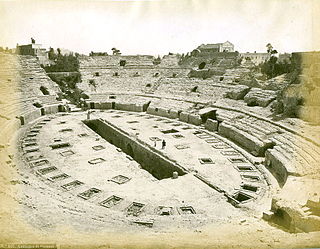
The Flavian Amphitheater, located in Pozzuoli, is the third-largest Roman amphitheater in Italy. Only the Roman Colosseum and the Amphitheatre of Capua are larger. It was likely built by the same architects who previously constructed the Roman Colosseum. The name "Flavian Amphitheater" is primarily associated with the Roman Colosseum.
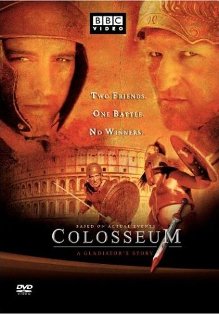
Colosseum: Rome's Arena of Death a.k.a. Colosseum: A Gladiator's Story is a 2003 BBC Television and France 2 docudrama which tells the true story of Verus, a gladiator who fought at the Colosseum in Rome.
Konfrontacja Sztuk Walki better known by its initials KSW, is widely considered to be the premiere mixed martial arts organization in Poland and one of the leading in Europe.
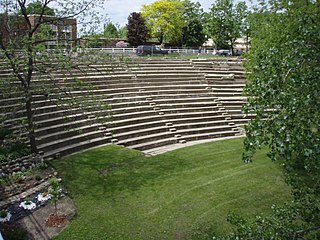
Windego Park Auditorium/Open Air Theater is an amphitheater in Anoka, Minnesota, located on the Rum River. The theater was built in 1914 and was spurred by the City Beautiful movement, as well as Anoka citizens' interest in outdoor entertainment and recreation. Its main organizer, Thaddeus P. Giddings, was a promoter of music education and had been organizing community singalongs in the summer of 1913. The theater is listed on the National Register of Historic Places.

Damnatio ad bestias was a form of Roman capital punishment where the condemned person was killed by wild animals, usually lions or other big cats. This form of execution, which first appeared during the Roman Republic around the 2nd century BC, had been part of a wider class of blood sports called Bestiarii.

The Billboard Live Music Awards is an annual meeting sponsored by Billboard magazine that honors the top international live entertainment industry artists and professionals. Established in 2004, it has thus been described as "part industry conference, part awards show".

Roman amphitheatres are theatres — large, circular or oval open-air venues with raised seating — built by the ancient Romans. They were used for events such as gladiator combats, venationes and executions. About 230 Roman amphitheatres have been found across the area of the Roman Empire. Early amphitheatres date from the Republican period, though they became more monumental during the Imperial era.

A tessera was the ancient Roman equivalent of a theater ticket. Stamped into a clay shard was an entrance aisle and row number for spectators attending an event at an amphitheater or arena. Above the doors of the Colosseum in Rome are numbers corresponding to those stamped into a spectator's tessera. Tesserae frumentariae and nummariae were tokens given at certain times by the Roman magistrates to citizens, in exchange for which they received a fixed amount of wheat or money.

Mastaura, was an ancient Greek town near Dereağzı, Nazilli in northern Caria, not to be confused with ancient Mastaura (Lycia).

Architextiles refers to a broad range of projects and approaches that combine architecture, textiles, and materials science. Architextiles explore textile-based approaches and inspirations for creating structures, spaces, surfaces, and textures. Architextiles contribute to the creation of adaptable, interactive, and process-oriented spaces. Awning is the most basic type of architectural textile. In Roman times, a velarium was used as an awning to cover the entire cavea, the seating area within amphitheaters, serving as a protection for the spectators against the sun.
